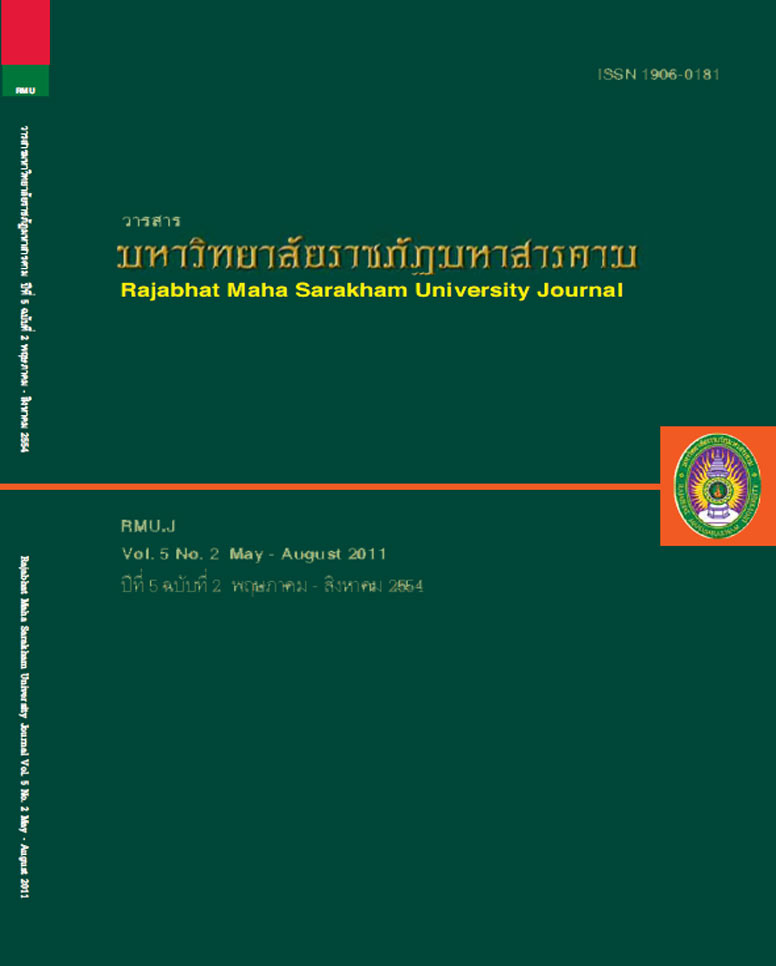การเปรียบเทียบผลการเรียนรู้กลุ่มสาระการเรียนรู้คณิตศาสตร์ เรื่อง เศษส่วนและทศนิยม ของนักเรียนชั้นมัธยมศึกษาปีที่ 1 ระหว่างการจัดกิจกรรมการเรียนรู้โดยใช้สื่อโปรแกรม จีเอสพี กับการจัดกิจกรรมการเรียนรู้ตามปกติ; Comparison of Mathematics Learning Outcomes in
Main Article Content
บทคัดย่อ
การเรียนการสอนคณิตศาสตร์หลักสูตรการศึกษาขั้นพื้นฐาน พุทธศักราช 2551 มุ่งเน้นพัฒนาผู้เรียนให้รู้จักการคิด
วิเคราะห์ สังเคราะห์ แสวงหาความรู้ด้วยตนเอง และมีความสามารถในการแก้ปัญหาทางคณิตศาสตร์ การสอนโดยใช้สื่อ
โปรแกรม จีเอสพี เป็นการสอนที่เน้นให้นักเรียนได้ค้นพบความรู้ด้วยตนเอง เนื่องจากโปรแกรมมีลักษณะสำคัญคือกระตุ้น
ให้นักเรียนมีความสนใจ ตื่นเต้น และสามารถทำความเข้าใจหรือหาคำตอบด้วยตนเอง การวิจัยครั้งนี้มีวัตถุประสงค์ประการแรก
เพื่อพัฒนากิจกรรมการเรียนรู้โดยใช้สื่อโปรแกรม จีเอสพี และกิจกรรมการเรียนรู้ตามปกติ ให้มีประสิทธิภาพตามเกณฑ์ 75/75
ประการที่สอง ศึกษาดัชนีประสิทธิผลของการจัดกิจกรรมการเรียนรู้โดยใช้สื่อโปรแกรม จีเอสพี และกิจกรรมการเรียนรู้ตาม
ปกติที่ผู้วิจัยได้พัฒนาขึ้น ประการที่สาม เปรียบเทียบผลสัมฤทธิ์ทางการเรียน ศึกษาความพึงพอใจ และประการที่สี่ เพื่อศึกษา
ความคงทนในการเรียนรู้ของนักเรียน กลุ่มตัวอย่างที่ใช้ในการวิจัยครั้งนี้เป็นนักเรียนชั้นมัธยมศึกษาปีที่ 1 ภาคเรียนที่ 2
ปีการศึกษา 2553 โรงเรียนไตรรัตนวิทยาคม สังกัดสำนักงานเขตพื้นที่การศึกษากาฬสินธุ์ เขต 2 จำนวน 58 คน เป็นกลุ่มทดลอง
และกลุ่มควบคุมกลุ่มละ 29 คน ได้มาจากการสุ่มแบบกลุ่ม (Cluster random sampling) เครื่องมือที่ใช้ในการวิจัยครั้งนี้
ได้แก่ แผนการจัดการจัดกิจกรรมเรียนรู้โดยใช้สื่อโปรแกรม จีเอสพี จำนวน 20 แผน แบบทดสอบวัดผลสัมฤทธิ์ทางการเรียน
ชนิดเลือกตอบ 4 ตัวเลือก จำนวน 40 ข้อ ซึ่งมีอำนาจจำแนกรายข้อตั้งแต่ 0.34 ถึง 0.96 ค่าความเชื่อมั่นทั้งฉบับเท่ากับ .98
และแบบวัดความพึงพอใจของผู้เรียนต่อการเรียนรู้เป็นแบบสอบถาม มาตราส่วนประมาณค่า 5 ระดับ จำนวน 20 ข้อ ซึ่งมีอำนาจ
จำแนกรายข้อตั้งแต่ 2.40 ถึง 5.67 ค่าความเชื่อมั่นทั้งฉบับเท่ากับ 0.60 สถิติที่ใช้ในการวิเคราะห์ข้อมูล ได้แก่ ร้อยละ ค่าเฉลี่ย
ส่วนเบี่ยงเบนมาตรฐาน และการทดสอบสมมติฐานใช้ t–test
ผลการวิจัยพบว่า
1. กิจกรรมการเรียนรู้โดยใช้สื่อโปรแกรม จีเอสพี มีประสิทธิภาพ เท่ากับ 81.70/81.64 และกิจกรรมการเรียนรู้ตามปกติ
มีประสิทธิภาพเท่ากับ 76.00/75.09 ซึ่งเป็นไปตามเกณฑ์ที่คาดหวังไว้คือ 75/75
2. กิจกรรมการเรียนรู้โดยใช้สื่อโปรแกรม จีเอสพี มีดัชนีประสิทธิผล เท่ากับ 0.7058 และดัชนีประสิทธิผลของกิจกรรม
การเรียนรู้ตามปกติ เท่ากับ 0.6008
3. นักเรียนที่เรียนด้วยกิจกรรมการเรียนรู้โดยใช้สื่อโปรแกรม จีเอสพี มีผลสัมฤทธิ์ทางการเรียนสูงกว่านักเรียนที่เรียน
โดยวิธีสอนตามปกติ อย่างมีนัยสำคัญทางสถิติที่ระดับ .05
4. นักเรียนที่เรียนด้วยกิจกรรมการเรียนรู้โดยใช้สื่อโปรแกรม จีเอสพี และกิจกรรมการเรียนรู้ตามปกติ มีความพึงพอใจ
ต่อการเรียนโดยรวมอยู่ในระดับพอใจมาก
5. นักเรียนที่เรียนด้วยกิจกรรมการเรียนรู้โดยใช้สื่อโปรแกรม จีเอสพี และกิจกรรมการเรียนรู้ตามปกติ มีความคงทน
ในการเรียนรู้
โดยสรุป กิจกรรมการเรียนรู้โดยใช้สื่อโปรแกรม จีเอสพี มีประสิทธิภาพและประสิทธิผลเหมาะสม นักเรียนมีความ
พึงพอใจและมีความคงทนในการเรียนรู้ สามารถนำไปใช้ในการจัดการเรียนการสอน เพื่อให้ผู้เรียนเกิดการเรียนรู้บรรลุผล
ตามจุดมุ่งหมายได้อย่างมีประสิทธิภาพ;
Mathematics learning and teaching in the Basic Education Curriculum 2008 focuses on developing
learners to have analytical thinking and mathematical problem-solving skills; and teaching by using the
Geometer’s Sketchpad Program (GSP) also emphasizes students’ discovery of knowledge by themselves.
The purposes of this study were 1) to develop learning activities by using the Geometer’s Sketchpad
Program and those using conventional teaching with a required efficiency of 75/75, 2) to find effectiveness
indices of students’ learning, 3) to compare students’ achievements and satisfaction, and 4) to examine
students’ learning retention.
The sample used in this study consisted of 58 students for 7th grade education attending
Triratwittayakom School in the second semester of the academic year 2010 under the Office of Kalasin
Educational Service Area Office 2 obtained by using the cluster random sampling technique. The
instruments used in this study were 20 lesson plans for organizing learning activities using the GSP
Program, a 40-item 4-multiple-choice achievement test with discriminating powers ranging .27 - .72
and reliability of .849, and a 20-item 5- rating-scale inventory on student satisfaction with discriminating
powers ranging 2.40 - 5.66 and reliability of .60. The statistics used for analyzing data were percentage,
mean, and standard deviation; and t-test was employed for testing hypotheses.
The results of the study were as follows:
1. The efficiency of the lesson plans based on the GSP Program was 81.70/81.64 while the
Conventional teaching had an efficiency of 76.00/75.09; both were consistent with the required 75/75
criterion.
2. The effectiveness index of the GSP Program was 0.7058 while the Conventional teaching had
an effectiveness index of 0.6008.
3. The students learning through use of the GSP Program had higher achievement than those taught
by conventional teaching at the .05 level of significance.
4. The overall satisfaction of the students learning through use of the GSP Program and the conventional
teaching was found at a high level.
5. The students learning by using the GSP Program and the conventional teaching approach had
learning retention.
In conclusion, the lesson plans for organizing learning activities by using the GSP Program were efficient
and effective, and the students had both satisfaction and retention in learning. And thus these activities
could be effectively implemented to enable learners to achieve their goa the GSP Program ls.
Article Details
1. บทความที่ลงตีพิมพ์ทุกเรื่องได้รับการตรวจทางวิชาการโดยผู้ประเมินอิสระ ผู้ทรงคุณวุฒิ (Peer Review) สาขาที่เกี่ยวข้อง อย่างน้อย 3 ท่าน ในรูปแบบ Double blind review
2. ข้อคิดเห็นใด ๆ ของบทความที่ลงตีพิมพ์ในวารสารมหาวิทยาลัยราชภัฏมหาสารคาม นี้เป็นของผู้เขียน คณะผู้จัดทำวารสารไม่จำเป็นต้องเห็นด้วย
3. กองบรรณาธิการวารสารมหาวิทยาลัยราชภัฏมหาสารคาม ไม่สงวนสิทธิ์การคัดลอกแต่ให้อ้างอิงแสดงที่มา


